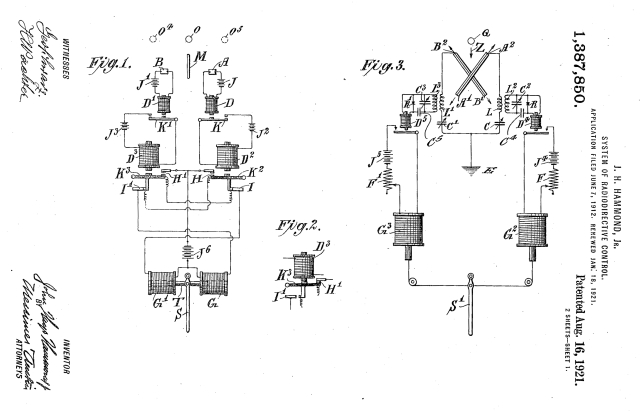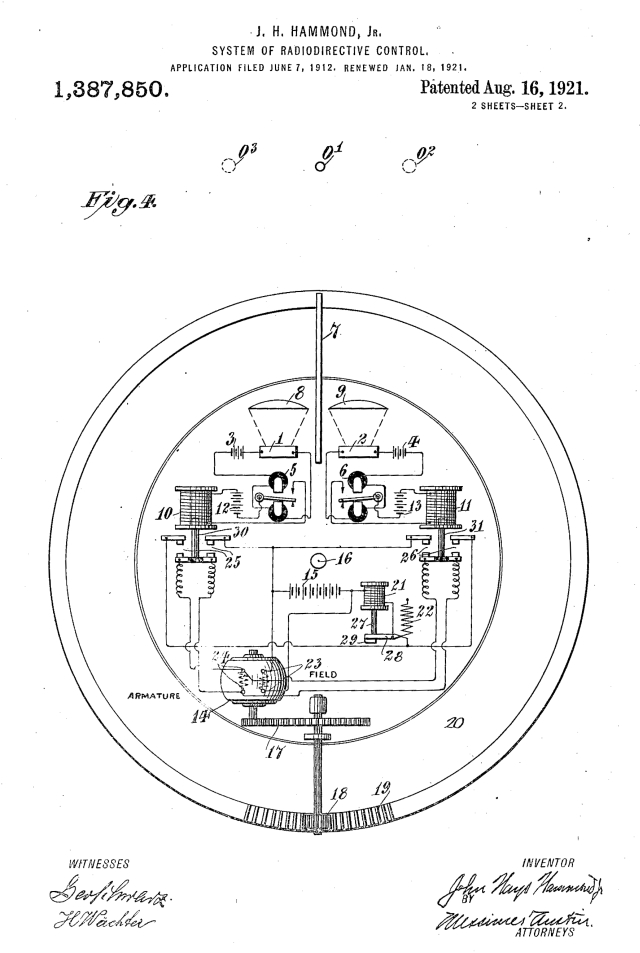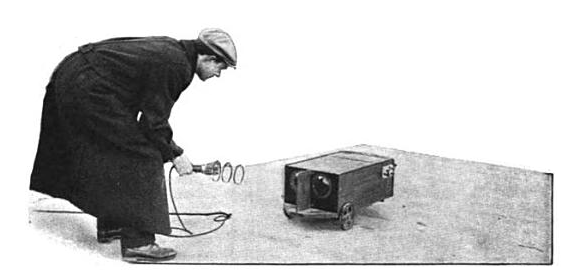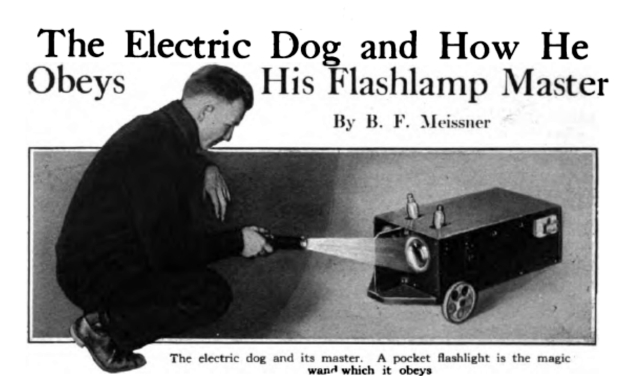A lot has already been published already about Seleno, try these links:
Here are some pics and excerpts showing different aspects of the "Electric Dog".
Technical articles on the Electric Dog appeared in Scientific American Supplement No. 2267 p376-7 June 14, 1919 written by Benjamin Franklin Miessner, in the Electrical Experimenter, 1915, p. 202. , and Popular Science Monthly.
Miessner described in some detail the behavior of the electric dog in Radiodynamics: The Wireless Control of Torpedoes and Other Mechanisms [Miessner, 1916].
Whilst the Electric Dog itself was not patented, certainly the technology was in terms of light guided missiles/torpedoes. Look up these in Google patents
Issue date: Sep 4, 1923
Issue date: Aug 16, 1921


As mentioned in another post on Enabling Technologies, one of the best references is:
Radiodynamics, By Benjamin Franklin Miessner (PDF file) – Chapter XXIV {24} (which begins on page 189 and continues through page 199) contains a description of the "orientation mechanism" that is the heart of Seleno, the Electric Dog. The entire book can be downloaded as a PDF file.
The earliest date I can find for Seleno is 1913, although Hammond was certainly exploring Selenium control since 1912 when he was looking at torpedo remote control. I tend to date on the creation of the model itself, rather than the underlying technology.
[Note: RH – Jan 2010 – see new addendum here that actually dates "electric dog" in 1912.]
Miessner vs Hammond : It appears the the Electric Dog was developed when Miessner worked for/with Hammond. Most of the articles the include the "Electric Dog" either have Hammond or Miessner, never both. It is unclear if they 'shared' the same dog, or the Hammond photographs are earlier than published, whilst Miessner seems to have the dog in latter years.
I have since seen a reference in a book by Miessner (1964) on "The Early History of Radio Guidance" where Miessner talks about Hammond loaning him the "Electric Dog" to demonstrate at a few lectures he was giving. At this time Miessner had already parted to work with the Navy and for further education.
[Note: RH – Jan 2010 – see new addendum here that actually dates "electric dog" in 1912 and gives the story on Miessner vs Hammond.]
FortWayneSentinel27021915p14ElectricDog
Selenium is Magic Eye Which Sees Hundreds of Miles; Controls Torpedoes and Crewless Airships
Young Scientist Predicts Marvelous Results from Experiments With Selenium—
Points to "Electric Dog" as Example of Its Possibilities.
(By Kenneth W. Payne.)
Lafayette, Ind., Feb. 27.—After seeing young Benjamin Franklin Miessner's "electric dog"—a small glass-eyed box on three wheels—actually pursue his
master about the room; after hearing Miessner predict that in time men in San Francisco will be able to witness a prize fight in Australia; after seeing a flattened bullet with which Miessner nearly killed himself while perfecting a magic "thief catcher;" after hearing him say that right now he could guide an absolutely unmanned Zeppelin from a boat in the English channel on a raid over coast towns; and after—
Well, naturally, after all this voyage into the land of miracles, one is too thrilled and dazed to know how to begin writing a story in a conservative, unenthusiastic way.
Yet this story must be told, for it concerns some extraordinary experiments with the element, selenium, which are taking place right under our noses in America today, and about which, in spite of their vast significance, only a few scientists know anything at all as yet.
Let's begin at the beginning, with Selenium.
"It's one of the elements,'' Miessner explained. "It comes in bluish-gray slicks which look like sealing wax; and it costs about $3 an ounce.
"Selenium has the peculiar property of changing its electrical resistance when influenced by light. That's the simple secret of all the weird things that scientists are doing with it."
Miessner is only twenty-five year's old now, a graduate of the Huntingburg (Ind.) high school, and of Uncle Sam's navy. After serving three years in the radio-telegraphic department of the navy, he worked for two years with John Hays Hammond, Jr., at the interesting job of steering deserted ships all over Gloucester harbor from a wireless station on shore.
Now Miessner is studying for a degree at Purdue university—and incidentally telling his learned professors a few things about radio-telegraphy and electrical engineering which they never heard before.
To illustrate his experiments, Miessner called his electric dog. From an electric flash he threw a bright light in the dog's goggly eyes, and the strange object at once ambled obediently out toward his master. Wherever Miessner went, about the room with that light, he dog patiently followed, as inexoribly compelled as the moth by the flame.
"The electric dog has two cells of selenium, one behind each of those glass
eyes," explained Miessner. "When I throw the light upon him, if it falls upon either eye it reduces the electrical resistance of the selenium, as I explained before and and an electrical current is allowed to pass through, starting the motor which turns the dog's wheels. He begins to advance. But if the light comes from the right, say, it hits only the right eye, because of the projecting screen between the eyes, then the current passes through that, eye, only and not through the other. An arrangement of batteries and electro-magnets then pulls the little rear wheel to the right and that turns the dog straight towards light, whereupon it shines in the other eye also, and the current passing through this eye charges an electro-magnet which pulls the little wheel, or rudder straight again. So you understand whenever the dog sees a light, he simply has to go.
"Now, we can make our electric dog over into a 'dog of war.' By simply readjusting the mechanism, the two selenium, eyes can be made to pursue a dark object amid light surroundings.
Supposing a torpedo fitted with such apparatus were launched from shore on a bright day toward an attacking fleet.
The battleships would stand up as the only dark objects against the bright sky and the torpedo would head straight for them with infallible and inescapable precision.
"A change in the mechanism makes it possible to drive your electric dog, or torpedo, or Zeppelin, away from "you by prodding it behind with a search–light, instead of pulling it toward you."
Miessner threw over a switch on his electric dog, and then when he flashed the light on the bulging eyes, the dog promptly, almost fearfully, backed away.
The marvelous see-at-a-distance projects of which Miessner talks, are based also on the ligut sensitivity of selenium, the "magic eye." The apparatus consists roughly of a great "compound eye," composed of some ten thousand selenium cells, each cell connected with a similarly situated glowlamp on the receiving apparatus. The selenium cells are unequally illuminated "by the light which falls on them from the objects within their range of vision, thus allowing currents of varying strength to pass through, they will light their respective glow-lamps in exact reproduction of the light and shadow of the objects before them.
"By a somewhat similar apparatus photographs have actually been transmitted by wire from Monti-Carlo to Paris, and published in the papers." Miessner commented.
The selenium thief-catcher invented by Miessner consists of a selenium cell with guns, bells, a camera and flash light. As soon as the light of the burguIar's dark lantern hits the selenium eye the whole array of noise makers goes off in one grand hubub. The thing's practical, because Miessner tried it out before a meeting of the Electric club in Chicago, recently, and nearly frightened the club out of its wits, besides taking a very good photograph of himself.
(Picture caption)
This extraordinary photograph—the first selenium-snapped picture ever published in Fort Wayne— shows Benjamin F. Miessner, surprised by his own burglar-catcher. Miessner was on the darkened stage before a meeting of the Chicago Electric club. When the flashlight in his hand hit the selenium cell—the small white object on the standard at 10ft—a gun was fired, a flash of powder went off, bells rang, and the camera took this picture. Below, Miessner drawing his electric dog toward him with a pocket electric lamp.
The canine's selenium eyes arc located behind the two glass lenses, in vacuum tubes whose tops form the dog's "ears" in this picture. His nose is the screen projecting between the eyes, which prevents light falling on both unless it is situated directly in front.
An interesting article describing the possible futures of the "Electric Dog".
Washington Post 02 May 1915 p55
Dog That Does The Housework
A SURPRISE FOR THE BURGLAR—THE ELECTRIC DOG IS AS GOOD A
WATCHER AS HIS FLESH-AND;BLOOD COUNTERPART.
MECHANICAL CREATURE THAT WILL FIGHT BURGLARS, SWEEP
AND DUST AND BE GENERALLY USEFUL.
[Technical World Magazine ]
He is a queer-looking dog. He has only three legs. He doesn't bark, bite, nor chase the neighbors chickens. He is even at peace with the family cat, which purrs contentedly as it ;vetches with speculative mien the peculiar antics of this unknown thing which seems to be at the beck and call of his master. Of course her feline, majesty doesn't know he isn't a reel dog. She judges so only from hearsay—that is, she heard some one say, "Oh, isn't he a wonderful dog!" – So she trusts her ears and doubts her eyes. This dog possesses none of the malicious characteristics of "Snarleyow, the Dog Fiend." Rather, he could be likened to faithful "Old Dog Tray." His cost—that bugbear word in these days of high prices and low wages—is merely nominee. As to food, that is nil. Regarding repose, like the famous detective, he never sleep's. In fact, his every action is guided by the rays that penetrate his material being.
The eyes of this melancholy-looking creature are of bulging glass, each one as large as a saucer. Hie body is an oblong mahogany box, which contains an electric motor, a storage battery, two selenium cam, two relays, and two solenoid magnets. He has no tail to speak of, but in its place is an electric switch. He is controlled by three brass wheels, two in front and one in the rear.
When the motor inside the dog is started he will do some extraordinary things. If you walk before him carrying a lighted lantern, he will follow you, turning to the right or left as you turn, although you neither touch nor control him in any way that is visible to the spectator. He steers himself briskly after his leader in a way that is positively uncanny.
The mystery is solved, however, when it is explained that what guides him is the light from the lantern, which operates upon the strangely sensitive element called 'selenium. If this light is moved to the left, the left selenium cell receives more of it and thus more stimulation than the right veil, and so allows more current to flow from the storage battery into the left-hand magnet, which then deflects the hind wheel to the left and the dog turns in that direction. For the same reason. when one turns to the right, the dog follows. If one wants the dog to go backward, all that is necessary is to reverse the tail switch. Then. when his master advances on him with the light. he will seemingly become timid and back away in a most surprising manner. But how can this annual be made useful? Welt, so far, of course, the Held has not been thoroughly explored; but there are certain household utilitarian purposes to which we might imagine he may be adapted.
Sweeping rugs and carpets constitutes one of the numerous duties of the housewife. The form of drudgery may be done away with by utilizing the electric dog. While vacuum cleaners and patent carpet sweepers have to a certain extent supplanted the old-fashioned but still efficient broom there, is yet a necessary amount of manual labor required to operate either of them_ By a very simple arrangement a rotary brush, similar to that used by street railways to sweep the tracks, could be attached to the rear of the dog. together with a pan to catch the refuse from the floor. – Then, with a pocket electric light or a small dark lantern in her hand, used as a guiding star. the lady could take her ease in a chef: and direct across the carpet the course of this faithful and tireless servant.
In flats or houses not Wired for electric lights the dog may be used to help out the housewife with her sewing. in Order to attain this result it would be necessary to have a grooved wheel. a simple accessory that could easily be attached to the mechanism of the apparatus. The latter could then be clamped to a box of convenient height, the sewing machine strap removed from the large wheel and adjusted to the grooved wheel of the dog. A pocket flashlight is installed where the operator could reach it with her foot. By pressing a button, the light could be turned on or off at will, thus starting or stopping the machine as desired.
One of the tables on wheels used for carrying kitchen dishes from the dining table into the kitchen might easily be mounted on the back of the dog. He could be made to follow the maid or mistress about as she piled the plates, cups, saucers, &c, on the top, and then follower her into the kitchen.
Also, there could be arranged on the top of this table a receptacle for the aby, in which it could be placed for its afternoon nap. Directed by the rays, the whole apparatus; would traverse the room and a mechanism could automatically reverse an electric switch after the vehicle lad gone a certain distance, and compel t to retrace its path. In the course of erne, and with proper development, this selenium dog, with his accessories, might 3e utilized in the moving of heavy furniture, such as pianos, tables, refrigerators and trunks, and thus assist materially luring the trying days of Baring cleaning. There are various other devices in which this peculiar animal, with his sensitive attributes, could be utilized. He could. be used for a burglar alarm, in connection with an electric battery and relay. This may be wired to the alarm bell proper. connected with dry batteries, wherever it may be deemed advisable place the alarm bell—if in the home, in the bedroom of the head of the house; if in the office, the wire may lead to the nearest police station. When the gentlemanly burglar enters the room and flashes his electric pocket light, its rays will strike the selenium cell and the gong will ring. But this is not &1 that may be accomplished. If a little mechanical ingenuity is brought into play. A. revolver and a camera might be added to the equipment to complete the discomfiture of the burglar The revolver. aimed in his direction, would either cripple him or give him a good fright, while at the same time a flashlight would enable the camera, to take a photograph of him.
By mounting a revolver drum or capstan on the dog, and equipping the head of each flight of stairs with a hook, the dog could be made to pull himself from floor to floor, in order to fulfill his household duties anywhere in the structure Inasmuch as .-he would be a heavy dog, this !might be necessary. but of course, he could be made to carry loads on his back while climbing. For instance, he could take the family washing from the laundry, carry it to the stairs, and. when planks are laid, and his rope connected to the hook, he would carry it up to the floor where a was wanted.
By mounting a row of three auxiliary eyes, each with a different-colored glees in front of it, even greater results would be secured. Turning on a red light would actuate only the red cell, Inasmuch as the light would not pierce the blue and yellow filters. f some place In expected to burst forth into flame—as. for instance. a rubbish heap—the doe might be. put on watch. ready to Send an alarm if red and yellow light from an incipient fire fan upon his eyes. For ordinary household use, a lantern equipped with white, red. yellow and blue eyes could give a. variety of signals that would cause the,dog to perform a multitude of tasks.
A refinement that would immensely increase his usefulness would result if his eyes could be kept turned toward the light, no matter where he should be in the room. With such a device, and mirror opposite the doer, the dog could even be sent out of the room on errands. Truly, the possibilities for the electric dog ere endless
The following 2 images located on David Szondy's site here.


Popular Science Monthly March 1916.
It didn't take long for other students at the time to be inspired…
Moberly Daily Monitor 14th May 1915 p3ElectricDog
(no pic)
Electric Dog Is Faithful
That engineers do not lose interest in animal life by dealing with machines is proved by the fact that the electrical engineering students of Highland Park college, Des Moines, Iowa, are making a dog which will follow his master all over the place.This dog consists of a small box shaped like the animal with two rather prominant eyes in its head.
The eyes are made of metal Selenium . Thin mechanical dog moves his head around until he sees a light; when he at once fixes his eyes intently upon the light toward which be moves rapidly.
It in only necessary for the dog's master to carry around an electric light, a pocket search light, or something of the kind to cause the, dog to follow him. The inside of the dog, made entirely by students of Highland Park college, consists off wires, Motors, and other electrical elemients. If this mechanical dog loses his master, he stands still and moves his head around until he discovers the light again.
One Reply to “1912 – Seleno, the Electric Dog – Hammond / Miessner”
Comments are closed.